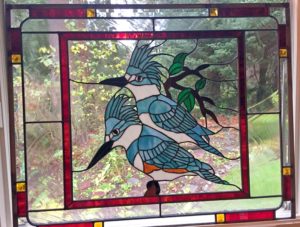 A good friend and co-author of our book, “How NOT to Be A Leader,” Kim Obbink, once told me, “Art will save you.” She was a successful CEO of a company and looking to retire. She was also a very talented artist. She explained to me that when she got stuck at work, or couldn’t see her way through a problem, she would go to her studio and paint or make something. The sheer act of creating art freed her mind up to look at the problem differently. I have been a stained glass artist since 2012 and she was trying to encourage me to spend more time in my studio. It worked. Not only did I solve the problem we were discussing but my business has thrived the more time I spend in the studio.
A good friend and co-author of our book, “How NOT to Be A Leader,” Kim Obbink, once told me, “Art will save you.” She was a successful CEO of a company and looking to retire. She was also a very talented artist. She explained to me that when she got stuck at work, or couldn’t see her way through a problem, she would go to her studio and paint or make something. The sheer act of creating art freed her mind up to look at the problem differently. I have been a stained glass artist since 2012 and she was trying to encourage me to spend more time in my studio. It worked. Not only did I solve the problem we were discussing but my business has thrived the more time I spend in the studio.
Apparently, we aren’t the only ones who use creativity and art to solve business problems. A recent article in the Harvard Business Review called, “The Best Leaders See Things Others Don’t. Art Can Help” shows how “cops and docs” can look at their work completely different by exercising that creative side of their brain to solve the problem or identify what they missed.
As we know with “confirmation bias” – the phenomenon that causes us to look only at the proof for what we already know vs. that which may question our “proof” – we look at situations through the lens of what we already know. However, innovation can only happen when we try a new approach. If we’re not looking at it through new eyes, or searching for what we don’t know, we’ll only create what we’ve already created, crushing innovation.
The beauty of using art to bring out new thinking is that art is completely subjective. What is beautiful to one is completely weird to another. I just went to an art show yesterday in Seattle and skidded by the art that wasn’t to my liking but spent a ton of time where the paintings spoke to me. I “saw” in them new things, maybe what I wanted to see or maybe even what the artist intended. The point is, no art is wrong – it’s all creative.
Creativity leads to innovations – new products, new ideas, new ways of doing things. To be creative we have to pull ourselves outside of the “known zone” where we are masters of the universe. We have to imagine that we are kindergarteners with all the wide-eyed wonder of a 5-year-old looking at the problem or situation. Because we “know” so much, we will rule out most ideas as bad, but if we are artists and no idea is a bad one what else can we create? I’m not saying to try ideas that will obviously prove disastrous but to look newly – through your “Picasso eyes” – and see what you see. Maybe, just maybe, art will save you.
